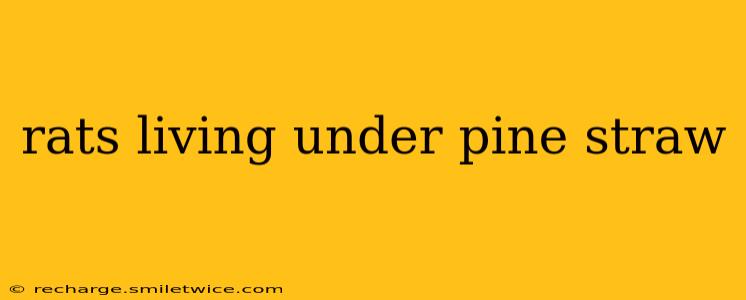Pine straw, with its attractive appearance and natural properties, is a popular choice for landscaping. However, its usefulness as mulch also inadvertently creates a welcoming habitat for rodents, particularly rats. Understanding how rats utilize pine straw, the risks they pose, and effective control methods is crucial for homeowners and landscapers alike.
Why Do Rats Live Under Pine Straw?
Rats are opportunistic creatures, seeking shelter, food, and water sources. Pine straw offers all three. The loose, insulating nature of pine straw provides excellent nesting material and protection from predators and the elements. The ground underneath often holds insects and other small creatures that rats can prey upon, while moisture trapped within the straw provides a water source. Essentially, pine straw offers rats a readily available and comfortable living environment.
What Types of Rats Live Under Pine Straw?
While several rat species might utilize pine straw, the most common culprits are likely Norway rats ( Rattus norvegicus) and roof rats (Rattus rattus). Norway rats prefer ground-level nesting areas and are more likely to be found directly beneath or within thick layers of pine straw. Roof rats are more agile climbers and might use pine straw near structures as a pathway to reach higher areas. Identifying the specific rat species can influence the choice of control methods.
Are Rats Under Pine Straw Dangerous?
Yes, rats living under pine straw pose several risks. They are known vectors for diseases like leptospirosis, hantavirus, and salmonellosis, which can be transmitted through their urine, droppings, and saliva. Their gnawing activity can damage property, including landscaping features, foundations, and even electrical wiring. Furthermore, their presence can be a nuisance, disrupting outdoor activities and causing psychological stress for homeowners.
How Can I Tell if I Have Rats Under My Pine Straw?
Detecting rat activity under pine straw can be challenging, but several signs might indicate their presence:
- Droppings: Look for dark, rat-sized droppings scattered near the pine straw.
- Runways: Notice any well-worn paths or flattened areas in the pine straw indicating regular rat traffic.
- Nests: You might discover nests made of shredded pine straw, other plant material, and sometimes even discarded human debris.
- Gnawing: Check for signs of gnawing on plants, wood, or other materials near the pine straw.
- Unusual noises: At night, you might hear scurrying sounds or squeaking coming from under the pine straw.
How to Get Rid of Rats Under Pine Straw?
Eliminating rats from your pine straw requires a multi-pronged approach focusing on sanitation, exclusion, and rodent control.
- Remove Food Sources: Ensure proper garbage disposal and eliminate any food scraps, spilled pet food, or accessible compost piles that might attract rats.
- Reduce Water Sources: Repair any leaky pipes or standing water near the pine straw.
- Remove Clutter: Clear away any debris, woodpiles, or overgrown vegetation that provides shelter near the pine straw.
- Reduce Pine Straw Depth: A shallower layer of pine straw reduces the attractiveness of the area as a nesting site.
- Use Rodent Repellents: While not a guaranteed solution, some commercial repellents might deter rats. However, their effectiveness varies.
- Trapping: Using snap traps or live traps can effectively remove rats. Be sure to check and bait traps regularly.
- Professional Pest Control: For severe infestations, it is advisable to contact a qualified pest control professional for effective and safe rodent control.
What are some natural ways to deter rats from my pine straw?
Several natural methods might deter rats, although effectiveness varies. These include:
- Planting rat-repelling plants: Certain plants, such as mint, lavender, and rue, emit scents that might deter rats. However, their effectiveness is limited.
- Using predator urine: Predator urine (such as fox or coyote urine) can be used as a deterrent, although the scent fades over time.
- Maintaining a clean yard: As previously mentioned, a clean yard eliminates food sources and shelters, thereby discouraging rat activity.
By understanding the reasons why rats choose pine straw as a habitat and implementing effective control strategies, you can successfully manage rodent populations and maintain a healthy and pest-free landscape. Remember, prevention is always the best approach; regular maintenance and sanitation efforts can significantly reduce the likelihood of rat infestations.
